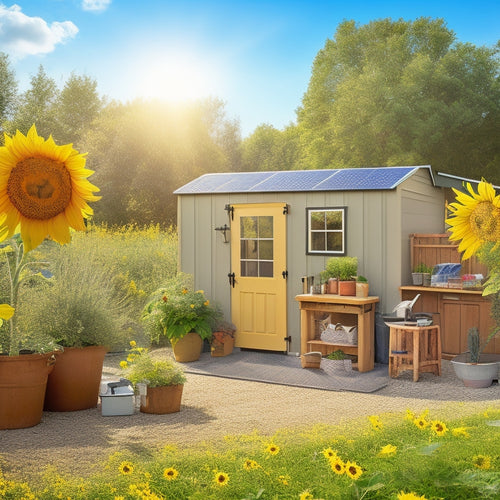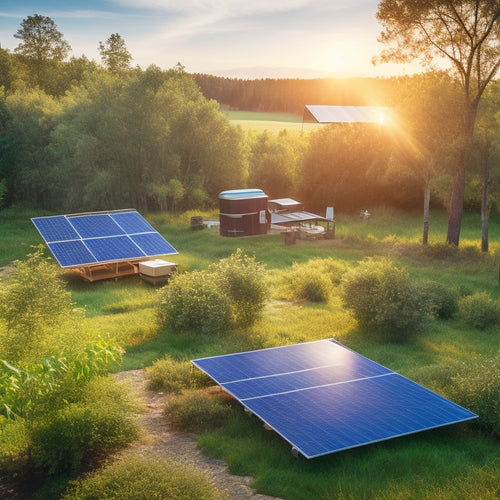
Small Solar Setup
Share
With a small solar setup, you can break free from reliance on the grid and release significant cost savings, while simultaneously reducing your carbon footprint and contributing to a cleaner environment. By understanding your energy demands and usage patterns, you can enhance your system's performance and maximize energy harvesting. Efficient tracking algorithms, like Maximum Power Point Tracking, guarantee ideal voltage for maximum energy production. To get the most out of your setup, it's essential to assess your energy budget and identify opportunities for energy-efficient upgrades. By taking the next step, you'll uncover how to tailor your small solar setup to your unique needs and reveal its full potential.
The Essentials
- A small solar setup can reduce energy bills and carbon footprint, contributing to climate change mitigation and air quality improvement.
- Selecting the right solar panel type and optimizing system installation are crucial for maximizing energy production and efficiency.
- Accurate assessment of energy demands and usage patterns is essential for sizing solar setups and identifying opportunities for energy-efficient upgrades.
- Energy harvesting and efficiency can be improved with Maximum Power Point Tracking (MPPT) systems and advanced algorithms that dynamically adjust to maximum power points.
- Government policies, tax incentives, and cost analysis can enhance project feasibility and support solar adoption for small solar setups.
Energy Independence at Home
You're taking an essential step towards energy independence at home by exploring solar power generation. This renewable energy source can greatly reduce your reliance on the grid, providing a clean and sustainable alternative.
By integrating a small solar setup into your home's energy infrastructure, you'll be generating your own electricity and enjoying the benefits of reduced energy bills.
With a home battery storage system, you can store excess energy generated by your solar panels, reducing the amount of energy you need to purchase from your utility company.
You can also shave peak demand charges and reduce your overall energy usage during those times of the day when energy rates are at their highest.
Solar Power Generation
With a small solar setup, generating your own solar power at home can be a significant step towards energy independence.
You'll need to choose the right solar panel types for your climate and energy needs. Installation tips include guaranteeing a secure and watertight mounting system, and enhancing panel angle and orientation for maximum energy production.
By opting for a complete solar power system kit with battery and inverter options Off-Grid Solar Kit, you can enjoy a cost-effective, low-maintenance, and portable alternative to traditional energy sources.
Battery storage is vital for storing excess energy generated during the day for use at night or during power outages. Regular system maintenance is necessary to guarantee peak performance and extend the lifespan of your system.
You'll also need to take into account inverter options, which convert DC power from your solar panels to AC power for your home. If you're grid-connected, you can sell excess energy back to the utility company.
A thorough cost analysis will help you determine the feasibility of your project, and don't forget to take advantage of tax incentives for renewable energy systems.
Energy monitoring systems will help you track your energy production and consumption. If you're feeling adventurous, think about a DIY project to get hands-on experience with your solar power system.
Renewable Energy Source
Achieving energy independence at home becomes increasingly attainable by utilizing renewable energy sources. As you consider a small solar setup, you're not only reducing your reliance on the grid but also contributing to a cleaner environment.
By investing in a reliable off-grid battery bank, such as a Deep Cycle Batteries solution, you can guarantee a steady power supply and overcome the challenges of unpredictable power outages and limited energy storage capacity. Government policies and solar incentives can greatly reduce installation costs, making renewable energy more accessible.
You'll want to stay informed about future technologies that'll improve energy storage and grid integration, facilitating a seamless shift to off-grid living. Community initiatives can provide useful resources and support as you steer through the process.
It's crucial to educate yourself on maintenance tips to make sure your system operates efficiently. Remember, a small solar setup is just the beginning – it's a step towards a larger movement.
By choosing renewable energy, you're promoting a cleaner, healthier environment and reducing your carbon footprint. As consumer awareness grows, so do the opportunities for innovation and progress.
Take control of your energy independence and join the movement towards a sustainable future.
Reduces Carbon Footprint Significantly
You'll greatly reduce your carbon footprint by switching to a small solar setup, which provides an eco-friendly energy source that's gentle on the environment.
By utilizing renewable energy from the sun, you'll lower your reliance on fossil fuels and guarantee lower emissions.
As a result, you'll contribute less to climate change and air pollution, creating a cleaner, healthier environment for yourself and future generations.
Eco-Friendly Energy Source
Utilizing energy from the sun reduces your reliance on fossil fuels, thereby slashing your carbon footprint considerably. By switching to solar power, you're not only contributing to a cleaner environment but also reaping numerous benefits. Here's a breakdown of the advantages you can expect:
| Solar Benefits | Description |
|---|---|
| Cost Savings | Lower your electricity bills by capturing free energy from the sun |
| Sustainable Living | Reduce your reliance on non-renewable energy sources and live more eco-friendly |
| Energy Storage | Store excess energy generated during the day for use at night or during power outages |
| Government Incentives | Take advantage of tax credits and rebates offered by the government for solar installations |
| Long Term Investment | Enjoy a long-lasting energy solution with minimal maintenance costs |
Lower Emissions Guaranteed
One of the most important advantages of switching to solar power is that it guarantees a substantial reduction in greenhouse gas emissions. By utilizing the sun's energy, you'll greatly lower your carbon footprint, making a positive impact on the environment.
This emission reduction is vital in combating climate change, and it's an essential step towards a sustainable future.
When you opt for a small solar setup, you'll be generating clean energy and reducing your reliance on fossil fuels. This, in turn, will lead to a considerable decrease in emissions, contributing to a healthier planet.
In fact, a solar power system can offset up to 3,000 pounds of carbon dioxide emissions annually, equivalent to planting over 100 trees.
Maximum Power Point Tracking
You'll want to guarantee your small solar setup incorporates a maximum power point tracking (MPPT) system, which optimizes energy harvesting by identifying the maximum power point of your solar panel.
This is particularly important when considering off-grid systems and renewable energy storage batteries, as they require efficient energy harvesting to function effectively.
The tracking algorithm's efficiency plays a critical role in this process, as it continuously monitors and adjusts the system to match the panel's maximum power point.
Tracking Algorithm Efficiency
Optimization is key in utilizing the full potential of your small solar setup, and that's where tracking algorithm efficiency comes into play. You want to guarantee your system is operating at its maximum potential, and that's where efficient tracking algorithms make all the difference.
By fine-tuning your tracking methods, you can maximize energy production and minimize losses. To achieve this, you'll need to make algorithm adjustments to account for variables like temperature, irradiance, and panel degradation.
A high-efficiency tracking algorithm will continuously monitor your system's performance, making adjustments on the fly to guarantee peak energy harvesting. This might involve adjusting the tracking frequency, tweaking the MPPT (Maximum Power Point Tracking) algorithm, or even implementing advanced techniques like fractional open-circuit voltage tracking.
Optimizing Energy Harvesting
Efficiency converges with innovation in maximum power point tracking (MPPT), the pinnacle of energy harvesting in small solar setups.
You're about to reveal the full potential of your solar panels. MPPT guarantees your system operates at the best voltage, maximizing energy production.
To get the most out of your setup, consider ideal solar panel placement to minimize shading. Pair this with suitable battery storage solutions and inverter selection customized to your system's specific needs.
Conduct a thorough shading analysis to identify potential energy losses. Regular maintenance tips, such as cleaning your panels, will also keep your system running at its best.
Proper system sizing is essential, so be sure to assess your energy needs accurately. If you're considering grid-tied options, weigh the cost considerations against the benefits.
Be prepared to overcome installation challenges, and don't forget to monitor your energy production to confirm you're getting the most out of your investment.
With MPPT, you'll be utilizing the power of the sun like a pro.
Assess Your Energy Demands
You need to understand your energy usage patterns to determine how much power your solar setup must provide.
Start by calculating your daily power requirements, including the wattage and operating hours of each device. This information will help you size your solar array and battery bank accurately.
As you investigate renewable energy storage options, consider integrating rooftop solar installations to maximize your energy output.
With off-grid systems, you can store excess energy generated during the day for later use, reducing your reliance on the grid.
Energy Usage Patterns
Evaluating your energy demands involves identifying the devices and appliances that consume power in your home or office, and understanding their energy usage patterns.
You'll need to pinpoint which devices are energy-intensive and when they're used most frequently. This information will help you optimize your energy consumption and create a more efficient solar setup.
To gain understanding into your energy usage, consider energy monitoring. This can be done using smart plugs or a whole-home energy monitoring system.
These tools provide real-time data on your consumption trends, helping you identify areas for improvement. By analyzing your energy usage patterns, you'll be able to determine which devices are the biggest energy hogs and make adjustments accordingly.
Understanding your energy usage patterns will also help you identify opportunities for energy-efficient upgrades.
For instance, if you notice that your lights are a significant contributor to your energy consumption, you may consider switching to LED bulbs.
Daily Power Requirements
Now that you have a better understanding of your energy usage patterns, it's time to assess your daily power requirements. To do this, you'll need to calculate your total daily power consumption.
Start by making a list of all the devices you plan to power with your solar setup, including lights, laptops, and refrigerators. Next, determine the wattage of each device and how many hours you'll use it per day.
Multiply the wattage by the hours used to get the total watt-hours (Wh) per day for each device. Add up the Wh for all devices to get your total daily power consumption.
This will give you your energy budget, which is essential for sizing your solar panel array and battery bank. Accurate energy budgeting is critical to guarantee you have enough power to meet your needs without oversizing your system.
Higher Efficiency Rate Guaranteed
You can greatly enhance power output by opting for high-efficiency solar panels, which employ advanced technologies to minimize energy losses.
These panels feature improved semiconductor materials, enhanced busbar designs, and optimized thermal management systems.
Boost Power Output
By upgrading to high-efficiency solar panels, you can greatly enhance your power output and guarantee a higher efficiency rate. This is vital in maximizing your energy independence and reducing your reliance on the grid.
When selecting solar panel types, consider high-efficiency options like monocrystalline or bifacial panels. These can increase your power output by up to 20%. Proper installation techniques, such as optimizing panel angle and orientation, can also improve your energy harvest.
Additionally, consider pairing your solar setup with battery storage to store excess energy for later use. Inverter selection is also essential, as a high-efficiency inverter can minimize energy losses during conversion.
Regular maintenance tips, like cleaning your panels and monitoring performance, can also guarantee peak operation. By conducting a thorough cost analysis and system sizing, you can ensure your solar setup meets your energy needs.
Frequently Asked Questions
Can I Install a Small Solar Setup on My Apartment Balcony?
You're considering utilizing solar power on your apartment balcony, but first, you'll need to check balcony regulations in your area to guarantee compliance. If allowed, you can achieve energy independence and reduce your carbon footprint, enjoying the freedom of generating your own clean energy.
How Long Does It Take to Recoup the Initial Investment Cost?
You'll want to calculate the payback period through investment analysis, considering factors like system cost, energy savings, and local incentives. This will give you a clear depiction of when you'll break even and start enjoying the fruits of your investment.
Are Small Solar Setups Compatible With Existing Electrical Systems?
As it happens, you're wondering about grid integration - can your existing electrical system harmonize with solar power? Fortunately, yes, most modern systems are designed for seamless integration, ensuring energy efficiency and freedom from the grid's constraints.
Do I Need to Clean the Solar Panels Regularly for Optimal Performance?
You'll want to clean your solar panels regularly to guarantee peak performance, as dirt and debris can reduce efficiency by up to 25%. Implementing a panel maintenance routine, along with other efficiency tips, will keep your energy output high and your independence intact.
Can I Expand My Small Solar Setup in the Future if Needed?
As you gaze up at your solar array, remember the American Dream: freedom from constraint. You're wise to contemplate expansion options - with future planning, you can scale up seamlessly, utilizing more energy and independence whenever you need it.
Final Thoughts
As you utilize the power of a small solar setup, you're not just reducing your carbon footprint - you're taking a giant leap towards energy independence at home. With maximum power point tracking, you'll maximize energy output. Assess your energy demands to guarantee a seamless changeover. For instance, a small solar setup can power a refrigerator for 24 hours on a single day's charge, illuminating the potential for a brighter, more sustainable future.
Related Posts
-

Building an Emergency Backup Solar Power System in 5 Essential Steps
Building an emergency backup solar power system involves five key steps. First, assess your daily energy needs to ide...
-

Solar Powered Lights for Sustainable Home Decor
Solar-powered lights offer a stylish and eco-friendly way to enhance your home decor. They capture sunlight, converti...
-

Top Off Grid Solar Batteries for Renewable Energy
When seeking top off-grid solar batteries for renewable energy, consider options with advanced battery chemistry, suc...


